Bwahahaha, this made my day. I'm sorry, but the translation errors are just too fantastic.
yeah, I should listen to my own advice and not use Google Translate. Last time I used it, I wished in Hebrew for mowque's kids to have lettuce.
"altar servant" as in altar boy (but not boy)Secondly, what were you meaning to say with "Alterdiener"?
I meant in the sense of "circle" but if it doesn't make sense in that particular context I'll make the changes.Thirdly, Zirkel. Zirkel means "pair of compasses", I assume you wanted something like "coven", but that would be "Hexenzirkel" - you can't lose the "Hexen-" bit.
Cheers for that, though now I almost want him to be known as "Leader who do the Demons' invoices"Lastly, Bestellungführer. That one made me laugh out loud. "Bestellung" is indeed a German word for "order". However, it means "order" as in "purchase", like an order at a restaurant or an order on Amazon. Your rank basically loosely translates as "guy who submits the order". An order as in the Order of the Garter is "Orden", so you want Ordensführer.
Last edited:





